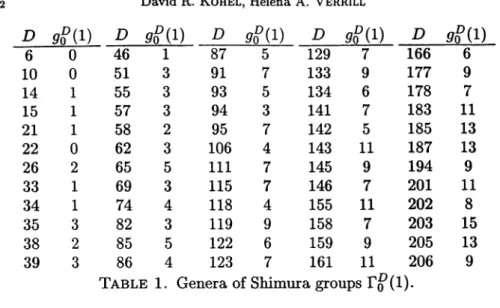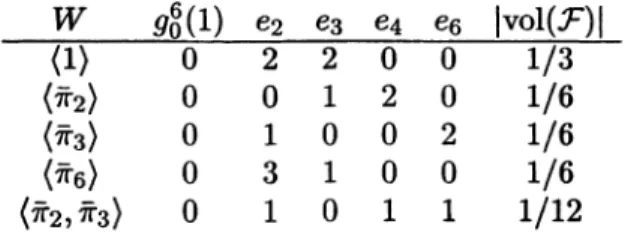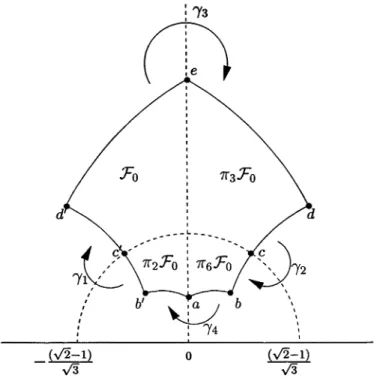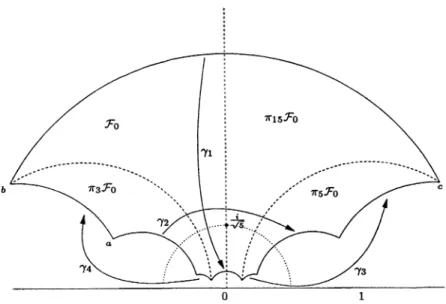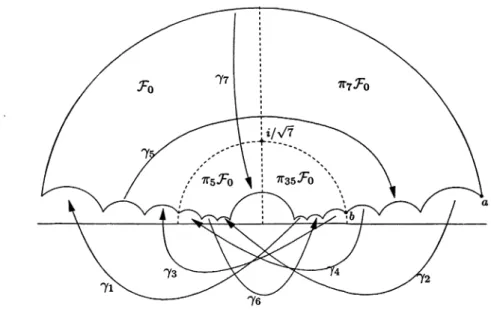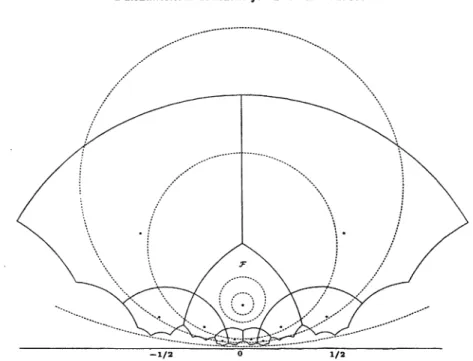J
OURNAL DE
T
HÉORIE DES
N
OMBRES DE
B
ORDEAUX
D
AVID
R. K
OHEL
H
ELENA
A. V
ERRILL
Fundamental domains for Shimura curves
Journal de Théorie des Nombres de Bordeaux, tome
15, n
o1 (2003),
p. 205-222
<http://www.numdam.org/item?id=JTNB_2003__15_1_205_0>
© Université Bordeaux 1, 2003, tous droits réservés.
L’accès aux archives de la revue « Journal de Théorie des Nombres de Bordeaux » (http://jtnb.cedram.org/) implique l’accord avec les condi-tions générales d’utilisation (http://www.numdam.org/conditions). Toute uti-lisation commerciale ou impression systématique est constitutive d’une infraction pénale. Toute copie ou impression de ce fichier doit conte-nir la présente mention de copyright.
Article numérisé dans le cadre du programme Numérisation de documents anciens mathématiques
Fundamental domains for Shimura
curvespar DAVID R. KOHEL et HELENA A. VERRILL
RÉSUMÉ. Nous décrivons un
procédé
permettant de déterminerexplicitement
un domaine fondamental dans ledemi-plan supérieur
pour une courbe de ShimuraXD0 (N)
associée à un ordre d’unealgèbre
dequaternions
A/Q.
Un domaine fondamental pourXD0(N)
réalise uneprésentation
finie du groupe des unitésquater-nioniennes modulo les unités du centre. Nous donnons des
exemples
explicites
pour les courbesX60(1), X015(1)
etX035(1).
Lepremier exemple
estl’exemple classique
d’un groupetriangu-laire et le second est une version
corrigée
due à Michon de celui du livre[13]
deVignéras.
Cesexemples
sont aussi traités dans la thèse d’Alsina[1].
Le dernierexemple
est nouveau et fournit unmodèle des méthodes
qu’il
fautappliquer lorsque
le groupeagit
sans
points elliptiques.
ABSTRACT. We describe a process for
defining
andcomputing
a fundamental domain in the upper halfplane
H of a Shimura curveXD0 (N)
associated with an order in aquaternion
algebra
A/Q.
Afundamental demain for
X0D(N)
realizes a finitepresentation
ofthe
quaternion
unit group, modulo units of its center. Wegive
explicit examples
of domains for the curvesX60(1), X015(1),
andX035
(1).
The firstexample
is a classicalexample
of atriangle
groupand the second is a corrected version of that
appearing
in the bookof
Vignéras
[13],
due to Michon. Theseexamples
are also treated in the thesis of Alsina[1].
The finalexample
is new andprovides
a demonstration of methods to
apply
when the group action hasno
elliptic points.
1. Introduction to Shimura curves
Let
A/Q
be aquaternion
algebra,
and letO / Z
be a maximal order in A. We say that A is indefinite if A0Q
R isisomorphic
to the matrixalgebra
where
0*
is thesubgroup
of units ofpositive
norm, such that theimage
of
O§ /(+1)
is a discretesubgroup
ofPSL2(R).
We detine 1£ to be the upper halfcomplex plane,
on which weidentify
PSL2(R)
with via the standard actionby
linear fractional transformations. We denote theimage
ofO§ /(+1)
inPSL2(R)
by
where D is the discriminant of thealgebra
A/Q,
and define the Shimura curve to be analgebraic
model for thecompatification
of thequotient
rf?(l)B1£.
An Eichler order of index N in O defines asubgroup
ofrô (1)
which we denoteby
with
corresponding
Shimura curveXf (N) .
In the case of the
split quaternion algebra
A =M2(Q)
of discrimi-nant D =1,
and maximal order 0 =M2(Z)
we have the identificationC~+/{~1~
=PSL2(Z).
Thecompactification
of is obtainedby
adjoining
the cusps of1£,
and the Shimura curveXô (1)
can be identified with the classical modular curveX(l).
An Eichler order of index N inM2(Z)
isconjugate
to thering
of matrices uppertriangular
moduloN,
and thefamily
of curves can be identified with the classicalfamily
of modular curves
Xo(N).
When the
algebra
A isnonsplit,
thequotient
isalready
com-pact
and the Shimura curvesprovide
a new class of curves whoseJacobians are related to those of the modular curves
Xo(N),
where N =DM. While the structure of the groups
ro(N)
and the fundamental do-mains for their actions on 71 can be inferred from the group structure ofPSL2(Z)
and thecomputation
of cosets for thequotient
PSL2(Z)/ro(N),
for each discriminant D it is necessary to firstcompute
anew the groupstructure and a fundamental domain for the base group associated
to a maximal order of discriminant D.
We note that the above construction
depends explicitly
on the choice ofEichler order and the choice of
embedding
inPSL2(R).
The former choice has minimalsignificance-every
maximal order in an indefinitealgebra
isisomorphic,
so we are free to choose one which isconveniently
represented
forcomputation.
Theembedding
inPSL2(R)
issubject
touncountably
many
isomorphisms given by conjugation.
We reduce the latter choicehowever to a choice of a real
quadratic
subfield K of A and a K-basis forA, by
which we obtain anisomorphism
M2 (K) .
Choosing
a realplace v
ofK,
theisomorphism Kv £É R, gives
anisomorphism
AM2 (R) .
In the
sequel
wepresent
computations
of fundamental domains forsev-eral Shimura curves, with a
description
of the methods used. In the next section we discussrepresentations
ofquaternion
algebras
and the structure of units which we use for ourcomputations.
We follow with a review ofhyperbolic
geometry
and groupactions,
suHicient to prove the correctnessShimura curves
XJ5(1), X35(1),
of genera0, 1,
and3,
respectively,
in terms of anexplict representation.
Theexample
presents
theinitial obstacle that neither
Q( v’=3)
nor(a(~)
embeds in thealgebra
ramified at 5 and
7,
so there exist no torsion elements inr~5(N),
hence noelliptic points
to serve as base vertices for a fundamental domain.The
background
material for this work followsclosely
thecomprehensive
book ofVignéras
[13],
to which we refer the reader for further information. In addition we note astrong
overlap
with the recent work of Alsina~1~,
who,
inparticular,
computes
fundamental domains forXô5(1),
and classifies certain CMpoints
and other invariants of Shimura curves.2.
Representations
ofquaternion
algebras
One defines a
quaternion
algebra
A over a field K to be a centralsimple
algebra
of dimension four over K. The definition is oftenreplaced by
aconstructive one,
setting
A =K(x, y),
where x and y aregenerators
sat-isfying
relationsx2
=a # 0,
y2
=b 1- 0,
andxy
+ yx
= 0. In thisstudy
we restrict to the case of K =Q, although
much of what is said here for Shimura curvesgeneralizes
tototally
real number fields.As a first
example,
we consider thesplit quaternion
algebra
definedby
a = b = 1. There exists an
isomorphism:
We say that a
quaternion algebra isomorphic
to a 2 x 2 matrixalgebra
issplit.
A field L such that A 0K L Eéé
M2(L)
is said to be asplitting field
for aquaternion
algebra
A over K. A field extensionL/K
is asplitting
field for A if andonly
if it contains aquadratic
subfield which embeds in A. Forany number field K and
quaternion
algebra
A over K there existinfinitely
many
quadratic
splitting
fieldsL/.K
of A up toisomorphism.
As a second
example,
we consider thequaternion
algebra
over K definedas above with a nonsquare in
K,
and take thesplitting
field L =Q(t),
where t2
= a. Then we obtain thesplitting:
In the
sequel
we work withquaternion
algebras
overQ
definedby
such apresentation
and choose a matrixrepresentation
of this form.In the
study
ofquaternions
algebras
A over a number fieldI~,
theserves to
classify
thealgebra
up toisomorphism.
We say that A issplit
ata
place v
ifAv
=Kv
isisomorphic
to a matrixalgebra,
and otherwisesay that A is ramified at v. A
nonsplit quaternion
algebra
over a local field is a divisionalgebra
which isunique
up toisomorphism.
A classical result for Brauer groups of number fields says that A is ramified at afinite,
evennumber of
places.
We define the reduced discriminant of a
quaternion
algebra
overQ
to be theproduct
of the finiteprimes
whichramify
and say that A is indefinite or definiteaccording
to whether theprime
atinfinity
issplit
or ramified.3. Structure of units
We define the reduced trace and reduced norm
N(x),
respectively,
of an element x of a
quaternion
algebra
A to be the trace and determinant under any matrixrepresentation
of A. Oneeasily
verifies that these areelements of the center
K,
and that x satisfies a characteristicpolynomial
x2 - Tr(x)x
+N(x)
= 0. Hereafter we omit theadjective
reduced and referto the
trace,
norm, and discriminant associated to A.The existence of a
quadratic
characteristicpolynomial
forquaternion
elementsimmediately implies
that any element of aquaternion
algebra
A/Q
not in the center mustnecessarily
generate
aquadratic
extension.We can therefore
classify
the units in0*
as either torsionunits, existing
in some
cyclotomic extension,
or aslying
in the free unit group of a realquadratic
suborder of 0. In terms of the matrixrepresentation
ofelements,
it is standard toclassify
elements y
ofPSL2(R)
in terms of their trace aselliPtic
2),
parafe
(ITr(,)1
=2),
orhyPerbolic
>2).
According
to thisclassification,
theelliptic
elements have one fixedpoint
in
1-£,
whileparabolic
andhyperbolic
elements have one and two fixedpoints, respectively,
which arecuspidal-that is,
in theboundary
P (R)
of 1£. In the case of
nonsplit quaternion
unit groups0~.,
we find thatnon-trivial
parabolic
elements do notexist,
and the distinction betweenelliptic
and
hyperbolic
elements isprecisely
that ofcyclotomic
and realquadratic
units. Inparticular
we note that in aquaternion
algebra
overQ
theonly
cyclotomic
units are thosecoming
fromembeddings
of the fieldsQ( 3)
andQ( 1) .
In addition to the units in
O$ /(+1)
we introduce elements of thenor-malizer group of in
PSL2(R).
We can find nontrivial elementsusing
thefollowing
lemma.Lemma 3.1.
Let p
be aprime
divisorof D
=disc(A). If xp
is an elementof
Oof
norm p then1rp01r;l
=C7,
and theimage of
1rp is in
N(rô (1)).
Proof.
For a we have1rpOl1r;l
Ot
since 7rp is a unit inOe,
soOp
= 0 OzZp
is theunique
maximalorder,
definedby
Since the norm is
multiplicative,
it follows that EOp
for all x inOp .
Thelocal-global
correspondence
for lattices in Aimplies
that the resultholds
globally.
DMore
generally
thequotient
is known to be anelemen-tary
2-abelian group,generated precisely by
elements of this form.Lemma 3.2. The
isomorphic
to(Z/2Z)’’n,
wherem is the numbers
of prime
divisorsof D,
and isgenerated by
any setof
el-ements e 0 )
1
pil,
were are theprime
divisorsof
D.Proof.
See Michon[10]
orVignéras
[13,
ChIV.B]
DIf the trace of an element Jrp is zero then we obtain a new
elliptic
ele-ment in Thus whenTô (1)
fails to haveelliptic
elements we mayexploit
the existence ofelliptic points
of the normalizer to build afunda-mental domain for the group such that the vertices are
distinguished
points
of the curveAs our
computational model,
we make anexplicit
identification of withPSL2(R)
so that for a fixedquadratic
splitting
fieldK/Q,
we mayrepresent
an element 7r of the normalizerby
an element ofPGL+(K), 2
withoutextending
K toby
the square rootsViii.
We are able to
generate
"random" units in0*
by searching
for funda-mental units of realquadratic suborders,
which may have norm 1 or -1. The search for elements xp of norm p in 0 is facilitatedby taking
theproduct
of an element of norm -p with any unit in 0* ofnom -1,
whose existence isproved by
thefollowing
lemma.Lemma 3.3. An Eichler order in a
indefinite
quaternion
algebra
overQ
contains a unit
of
norm -1.Proof.
We define the discriminantform
to be the form4N (x)
on This form is a
ternary
quadratic
form of discriminant4 disc(O),
whichrepresents
the discriminants of thequadratic
subrings
in C~(see
Chapter
6 of Kohel[5]).
It suffices to show that the discriminant formrepresents
aprime p
congruent
to 1 mod4,
since then 0 contains a realquadratic
order of discriminant p, whose fundamental unit has norm -1.Since O is an Eichler order it is either ramified and maximal or
locally
iso-morphic
an uppertriangular
matrixalgebra
at each finiteprime.
In bothcases, the discriminant form is not zero modulo any
prime
p, inparticular
represents
the class of 1 mod4,
andby
theassumption
that Cl isform admits a
representation
of aprimitive
indefinitequadratic
form whichrepresents
1 mod 4.By
the Chebotarevdensity theorem,
this latter formrepresents
apositive density
ofprimes
1 mod4,
and the result holds. 0 We note that the lemma is false if O is not an Eichler order. Forexample,
if O is nonmaximal at a ramifiedprime
p - 3 mod4,
then the discriminant form is notprimitive,
as itrepresents
only integers
congruent
to 0 mod p, and noquadratic
order of this discriminant contains a unit of norm -1. The lemma also fails for aquaternion
order of the form Z +40,
whosenorm form
represents
only integers
congruent
to 0 or 1 mod 4.4.
I3yperbolic geometry
and group actionThe metric on H defines a volume measure which
permits
the effectivecomputation
of volumesof hyperbolic polygons
(see
Vignéras
[13,
Ch.IV]).
We define the arithmetic volume of such aregion
to be1 / (2~r)
times itshyperbolic
volume. If theregion
is a fundamental domain of any discretegroup
acting
on U such that iscompact
then the arithmetic volume is a rational number. Inparticular
we have thefollowing
formula for thisquantity
when 1~ =hô ( 1 ) .
Lemma 4.1. The arithmetic volume
giuen by
0
Proof.
SeeVignéras
[13],
Lemme IV.3.1. 0 Let r be an discreteco-compact
subgroup
ofPSL2(R)
and leten(r)
be the number ofelliptic points 2
of such that1 {¡
E r1 q(z)
=zll
= n where z is anyrepresentative
of 2 in ~-l.Lemma 4.2. The arithmetic volume
of
afundamental
domain Ffor
rsatifies
thefollowing
relation:where
g(r)
is the genusof
the Rierrcannsurface
Proof.
SeeVignéras
[13],
Proposition
IV.2.10. 0 Lemma 4.3. The numbers enof elliptic
elementsfor
F)(1)
satisfy
the identities:and en = 0
for
all ngreater
than 3. The numbers en are zeroProof.
SeeVignéras
[13,
Ch.IV.A-B].
D We nowgeneralize
the formulas for the numbers ofelliptic points
toinclude their normalizers.
Lemma 4.4. be an
elliptic
elementof
order n > 1 in and with arepresentative
in 0 f1A+ of
square-free
integral
norm m. Then m divides D and thepossible
combinationsfor
thesubring R
= c0,
the minimalpolynomial
of y,
and theintegers
m and n aregiven
in the
following
table.Proof.
Theprojective normalization ti
in AoQ
R of anelliptic
element -y
inN(rf?(1))
of norm m is a root ofunity.
On the otherhand,
the square of this element is an element ofC7+
=rô (1)
and so isquadratic
over Z. Therefore the normalizedelement JL
is contained in thebiquadratic
extension
a] .
Thepossible
roots ofunity
are those of order1, 2,
3,
4,
6 or12, giving
rise toelliptic
elements ofprojective
order1, 2, 3,
or 6.It follows that the
possible rings
and minimalpolynomials for,
are thosespecified.
IlFor a
prime
pdividing
the discriminant ofA,
ap-orientation
on a maxi-mal order 0 is ahomorphism
0 --+Fp2.
Anembedding
R C 0 is said to beoptimal
ifOIR
is torsionfree,
and an orientationdistinguishes
twoembed-dings
of 1~ into 0 which do not commute with a collectionof p-orientations
on 9 for each
prime
pdividing
the discriminant D. As aspecial
case ofCorollaire 111.5.12 in
Vignéras
[13],
the numberrn(O,R)
ofoptimal,
ori-entedembeddings
of aquadratic
subring R
in 0 isgiven by
where
dR
is the discriminant of R. We can now express the number ofellip-tic
points
for a group G in ternis of these invariants. Theorem 4.5. Let G be an extensionoff
= containedTABLE 1. Genera of Shimura groups
where the sum is over all
imaginary
quadratic
orders and whereProof.
This follows from the classification ofelliptic
elements in Lemma 4.4 and consideration of the ramification of the coverF% (1)(H
4>GB1-l.
D5.
Examples
We
present
hereexamples
of fundamental domains forrô(1),
rÕ5(1),
andf35(1).
Thisprovides
the base case from which domains for the familiesof
subgroups
can be studied. Wenote,
however,
that even withinthe collection of groups
rô (1)
associated to the maximal orders in rationalquaternion algebras
the genus of the Shimura curveXô (1)
may bearbi-trarily large.
For reference wedisplay
inFigure
1 the initial genera of the Shimura curves of discriminant D and index 1.5.1. Fundamental domain for
r6 (1).
The group is a well-knowntriangle
group in the literature. This group is treated in Alsina[1],
whereone also finds an
explicit description
of a fundamental domain. Iharaproved
that,
as an abstract curve, isisomorphic
to the conicX2
+y2
+3Z2
=0,
asreported
in Kurihara[9].
Elkies[4]
determinesequations
for thequotient
curve associated to thenormalizer,
and also treats severalexamples
of thesubgroups
N(rô(e))
for smallprimes
l.We
apply
Lemma 4.5 tocompute
the theelliptic
invariants for each of the extensions groups G withimage
W in(*2, ~3),
andpresent
this information with the genus and volume data in thefollow-ing
table. Theelliptic
points
will beexplicitly
determined aspart
of theFIGURE 1. Genus and invariant data for extensions of
fundamental domain
computation.
We define a
presentation
of thequaternion
algebra
A =Q(x, y)
of dis-criminant 6by
the relationsx2
=2,
y2
=-3,
and~y = -yx, and let 0 be the Z-module with basis
{1,
(x
+z)/2, (1
+y)/2, zl.
The module O isimmediately
verified to be closed undermultiplication
and forms a maximal order of A since the discriminant of its norm form is62
(see
Lemme 1.4.7 and Corollaire 1.4.8 ofVigneras
[13]
for thecomputational
construction and Corollaire III.5.3 for itsvalue).
We introduce arepresentation
A -~M2(R)
given by
under which
Fg ( 1)
acts on H.Without further
ado,
webegin by writing
down asystem
of units in .... ,,-’" "We moreover define the elements 1r2, and 1r6 of the
normaùzer N(FÉ (1))
by:
Together
with theidentity,
these elements form a set of cosetrepresenta-tives for the
quotient
andsatisfy
the additionalprojective
relations:Here
by projective
relation we mean that the relation holds up to someelement of
Q*.
We note that all of the above relations are verifiedby
elementary
means and areindependent
of any matrixrepresentation
orembedding
inPSL2 (R,~ .
With
respect
to the chosenrepresentation
we define thepoints
a,b,
andc to be the fixed
points
of the elements 4, and 2?respectively
specifically
these are thepoints:
From these
points
wedefine b’
_ -b andd
= -c to be the reflectionsaround the
imaginary axis,
and define elementsd,
d’,
and eby d’
=1T6b,
d =~sb’,
and e =Theorem 5.1. The
hyperbolic
with vertices(a, b, c, d, e, d’,
c’, b’, a) is
af’Undamental
domainfor
rg (1) .
Thepolygon Fo
with vertices(a,
b,
c,t),
where t = afixed point of
theelliptic
element 7r6 , isa f’Undamental
Proof.
Theedge gluing
relations for the domains JF andFo
are determinedby
theequations
(1)
and(3),
as can bedirectly
verified. A volumecomputa-tion shows that the volumes - 0.3333 and ~ 0.08333 agree with the known values of
1/3
and1/12
for and inFigure 1,
from which it follows that thepolygons
are not the union ofmultiple
domains. D From thegluing
relations on theedges
of the fundamental domains weobtain the
following corollary.
We note thatessentially
the samepresen-tation for
describing
as atriangle
group, appears in Elkies~4~ .
Corollary
5.2. Thegenerators
(1)
with relations(2)
give
afinite
presen-tationfor
the group Thegenerators
~r3 and 7r6 with redationsThe content of the
previous
theorem is summarizedgraphically
inFig-ure
2,
which shows a fundamental domain F for The subdivisions define four constituent fundamental domains7r2Fo,
and7r6FO
for the normalizer withboundary geodesics
formedby
theimaginary
axis and abisecting
arc stabilizedby
Theedge
gluing
relations arein-dicated
by
the arrows, and the actions of the 1rm are determinedby
their relations(4)
and the indicatedmapping
on the constituent subdomains of .F.FIGURE 2. Fundamental domain for
Iro 1
5.2. Fundamental demain for
rÕ5(1).
A fundamental domain forrô5(1)
andN(rÕ5(1)),
due toMichon,
appearsVignéras
[13],
IV.3.C. The domaingiven
below is normalized to be defined over thesplitting
fieldQ ( v’3),
to becomputationally
more effective than thebiquadratic
fieldQ(~/3, yS)
ofMichon,
and corrects errors in the book ofVignéras.
A similar correctedexample
also appears in the thesis of Alsina(1~,
also over thesplitting
fieldQ
We take the
quaternion
algebra
of discriminant 15presented
by
A =Q(x, y)
with the relationsx2
=3,
y2
=5,
and xy =-yx, and choose the maximal order 0
having
basis{1~,(1
+y) /2, (x
+z) /21.
As withthe
previous example
themaximality
of 0 is verifiedby
showing
that the discriminant of the associated norm form is152.
We embed A inM2(R)
by taking
The
elliptic
invariants and genus aregiven by
Lemmas 4.2 and 4.5 for eachof the extensions groups G with
image
W inN(rÕ5(l))/rÕ5(1) =
(*3, *5),
andpresent
this information with the genus and volume data inFigure
3. Withresepct
to thisembedding,
we obtain a fundamental domain F forFIGURE 3. Genus and invariant data for extensions of
rà5(1).
rÕ5(1),
pictured
inFigure
4.In the
figure,
points
a,b,
c aregiven by
All the other vertices of the domain can be
given
in terms of thesepoints,
and in clockwise order around thedomain,
the vertices of F aregiven
by
Theorem 5.3. The
region
F is afundarrzental
domainfor
rà5(1)
associ-ated to thegenerators
which
provides
rij5(1)
with thepresentation
Proof.
The relations can be verifieddirectly.
Thepoints
b and c are taken to be the fixedpoints
of q4qi and q3qirespectively,
and with this choice it can then be seen that all theedge
identifications of ~’ aregiven
by
-~1, ~y2, T3? q4 ,as indicated in the
figure.
Wecompute
the volume of theregion
to be N1.3333,
which agrees with theexpected
value of2/3.
The verification ofthe
relations,
together
with thecomputation
of the volume shows that theregion given
is indeed a fundamental domain forrô5(1).
D A set of cosetrepresentatives
for isgiven by
1 andwhich
satisfy
theprojective
relations:Theorem 5.4. A
fundamental
domainefor
N(rÕ5(1)
can begiven
by
aregion
,~p
having
verticesMoreover
N(rà5(1))
isgenerated by
the 1’1, ir3, and lrl5, and has a presen-tationProof.
Toverify
that.~o
is a fundamental domain for the normaliser wesimply
note that theedges
are identifiedby
elements in thenormaliser,
andthat
precicely
fourcopies
of this domaingive
the domain forr~5(1),
whichmeans this is a domain for a
subgroup
of the normalizercontaining
with index4,
but we know that 4 is the index ofrÕ5(1)
inN(rÕ5(1)).
Here we areusing
the fact that a is the fixedpoint
of1r31r151’111r31, in
adition to the choices of b and c asbeing elliptic points
forr~5 (1).
DFigure
4 shows the domain .~’ forr~5(1)
dividedby
the dashed lines into four fundamental domains forN(rÕ5(1)).
Thesedividing
lines are lines from vertices b to-ylb,
and from c to which are lines stabiliedby
7raand -y2ir3
respectively,
and theimaginary
axis.6. The fundamental domain for
r~5(1).
For the case of D =
35,
we take thequaternion
algebra
of discriminant 35presented by
A =~),
with the relationsx 2
=5,
y2
=7,
and
= -y~, and choose the maximal order C7having
basis{1, (1
+x)/2, (y
+~)/2,~}.
As in the
previous
examples,
themaximality
of this order isproved by
verifying
that the discriminant is352.
We embed A inM2(R)
by
taking
The
elliptic
invariants and genus aregiven
by
Lemmas 4.2 and 4.5 for each of the extensionsgroups G
withimage
W inN(r55(1))/r55(1) =
(iF5, ir7),
and present the genus and volume data inFigure
5.Figure
6 shows a fundamental domain forr~5 (1)
with respect to thisembedding.
In much the same way as in theprevious
examples,
we have thefollowing
theorem:FIGURE 4. Fundamental domain for
rÕ5(1)
and its normalizer.FIGURE 5. Genus and invariant data for extensions of
r~5(1).
Theorem 6.1. The groupsgenerated by
elementsand has a
presentation
This
presentation corresponds to
afundamental
domain JFfor
rô5(1)
given
where
and a is the
unique
point in
the upperhalf plane
fixed by
Jr35q7qiq6q2, where ~35 = z, and b =7r357r7a, were lr7 =
(y
+z)/2.
Proof.
Theproof
of this theorem is similar to the otherexamples.
The relations caneasily
beverified,
and one can check thatthe -yZ identify
theedges
of the domain. Then wecompute
the volume and show that up to avery small error we obtain the
expected
value of 4. 0The elements
together
with1,
give
theequivalence
classes ofN(rg5(1))/r35(1).
Projec-tively,
these elementssatisfy
the relations:Note that these
relationships
only
hold up tomultiplication by
some scalar. The dashed lines in thediagram
divide the fundamental domain into fourregions,
each of which is a fundamental domain for the normalizer. Fourcopies
of the domain form a fundamental domain forr~5(1)
as shown. The vertices of,~o
aregiven by
where c is the fixed
point
of 1r35. ·In the
diagram
theedge
identifications obtained from these elements areindicated.
’T.
Algorithmie
considerationsIn the construction of fundamental
domains,
it hasproved possible
tofind units
by
ad hocsearch,
which can be structuredby
firstsearching
for realquadratic
suborders of smalldiscriminant,
followedby
a fundamental unitcomputation
in that order. To find aprovably
deterministicalgorithm,
one needs todesign
a searchalgorithm
whichguarantees
that asystem
ofgenerators
will be found. For this purpose we invert thefollowing
stan-dard lemma(see
Vignéras
[13],
p.116)
tocompute
units inhyperbolic
neighborhoods.
Lemma 7.1. Let r be a discrete
subgroup
of PSL2(R)
and let z be apoint
in 1-£ which is not anelliptic
point
of
r. Then the setFIGURE 6. Fundamental domain for and its normalizer.
We invert this construction
by letting
=’YZ, for fixed z, define a
map
1-£,
andsearching
for elements of the finite setswhere
B (z, r)
is thehyperbolic
disc of radius r about z. Acomplete
set of groupgenerators
isprovided by
the elementsmapping
Fz
to anadjacent
domain,
so the searchregion
is sufficient as soon as the search radius r issufficiently
large
so thatB (z, r)
includes themidpoints
of alladjacent
domains.
We illustrate this
argument
for D = 6 inFigure
(7) .
The dashed circles are discs of variousradii,
centered at z =(.J2 -1)-N/3,
the fixedpoint
of1r6. The circle of radius
3,
for which the lowerboundary
isdrawn,
contains the domain7 = 7z
and all of itsneighbors.
Inparticular,
it containspoints
7~for -y
any of thegenerators
71, -y2, 73? or ’y4 forAs a final
computational
note we sketch thefollowing
reductionalgorithm
used to reduce of a new
generator
withrespect
to a currentsystem
ofgenerators
for a group h. Let z be a fixedpoint,
which is notelliptic point
for the group F and fix a radius r > 0.
Suppose
we have found units 7l? " ’ ’Ym such that r for each i. Then if we can find another element er withzi
r, we thenapply
the ’Yi to minimize1-yuz - zi,
where q
is aproduct
ofthe ,i
and their inverses. To dothis,
construct a, aI, ... , =fa as follows. Given let ai+i = such that
FIGURE 7. Fundamental domains for and
hyperbolic
neighborhoods.
either terminates with =
0,
in which case a is not a newgenerator,
or else at some other minimum
value,
in which case we setThe
computations
involved in this work were carried out withalgorithme
developed
in theMagma language
[2].
The authors’packages
for actions of congruencesubgroups
on the upper halfhyperbolic
plane
[12]
andquater-nion
algebras
[8]
were modified for thisstudy.
8. Future work
The authors
envisage
thisstudy
aspart
of a program tocompute
invari-ants of Shimura curves,extending approaches
through
quaternion
idealsand
supersingular
constructions(see
Kohel[6]
and[7])
andanalogous
tothe
undertakings
of Cremona[3].
Acomplementary project
to that dis-cussed here is thedevelopment
ofalgorithms
forcomputing
modularforms,
by
means of their Fourierexpansions along
the minimalgeodesic
of ahy-perbolic
element. Such astudy
should allow the effective determination of models forXD (N).
Further, by integration
along
paths
(z, ~yz),
one could determine theperiod
lattice of a curve as astep
towardsexperimentally
testing
andverifying analogues
of the Birch andSwinnerton-Dyer
conjec-tures for Shimura curves.References
[1] M. ALSINA, Aritmetica d’ordres quaternionics i uniformitzacio hiperbolica de corbes de Shimura. PhD Thesis, Universitat de Barcelona 2000, Publicacions Universitat de Barcelona,
ISBN: 84-475-2491-4, 2001.
[2] W. BOSMA, J. CANNON, eds. The Magma Handbook. The University of Sydney, 2002.
http://magma.maths.usyd.edu.au/magma/htmlhelp/MAGMA.htm.
[3] J. CREMONA, Algorithms for modular elliptic curves, Second edition. Cambridge University
Press, Cambridge, 1997.
[4] N. ELKIES, Shimura Curve Computations. Algorithmic Number Theory, LNCS 1423,
J. Buhler, ed, Springer (1998), 1-47.
[5] D. KOHEL, Endomorphism rings of elliptic curves over finite fields. Thesis, University of California, Berkeley, 1996.
[6] D. KOHEL, Hecke module structure of quaternions. Class field theory2014its centenary and
prospect (Tokyo, 1998), K. Miyake, ed, Adv. Stud. Pure Math., 30, Math. Soc. Japan, Tokyo (2001), 177-195.
[7] D. KOHEL, Brandt modules. Chapter in The Magma Handbook, Volume 7, J. Cannon,
W. Bosma Eds., (2001), 343-354.
[8] D. KOHEL, Quaternion Algebras. Chapter in The Magma Handbook, Volume 6, J. Cannon,
W. Bosma Eds., (2001), 237-256.
[9]
A. KURIHARA, On some examples of equations defining Shimura curves and the Mumford uniformization. J. Fac. Sci. Univ. Tokyo 25 (1979), 277-301.[10] J.-F. MICHON, Courbes de Shimura hyperelliptiques. Bull. Soc. Math. France 109 (1981),
no. 2, 217-225.
[11] D. ROBERTS, Shimura curves analogous to X0(N). Ph.D. thesis, Harvard, 1989.
[12] H. VERRILL, Subgroups of PSL2(R), Chapter in The Magma Handbook, Volume 2, J.
Can-non, W. Bosma Eds., (2001), 233-254.
[13] M.-F. VIGNÉRAS, Arithmétiques des Algèbres de Quaternions, LNM 800, Springer-Verlag,
1980.
David R. KOHEL
School of Mathematics and Statistics University of Sydney
Sydney, NSW 2006
Australia
E-mail : kohelomaths. usyd . edu . au
Helena A. VERRILL
Department of Mathematics
Louisiana State University
Baton Rouge, Louisiana 70803-4918 USA
